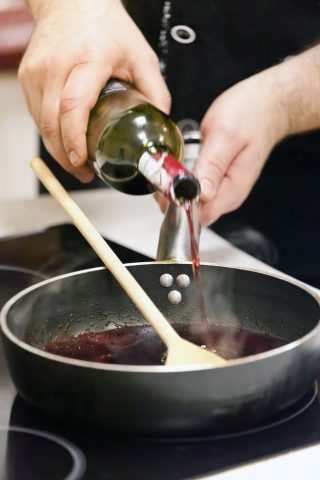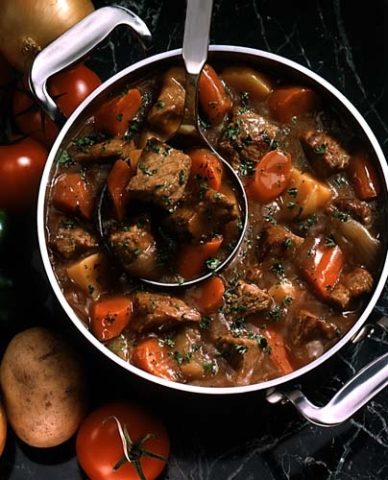Should You Cook With Expensive Wine or Cheap Wine?
By Andrew Meggitt
May 25, 2015 • Fact checked by Dumb Little Man

We all know that wine tastes great — well, most of it does. But what is it within the wine that enables us to enjoy it?

Just like the food we eat, wine comes in a vast array of flavors and styles. What makes each wine unique is the combination of sugars, acid, aroma compounds, tannin, and alcohol. These components, in differing combinations, give each wine its unique character.
From a culinary standpoint, these wine attributes can also enhance a dish. For example, with white meats or fish, you’d want to try a dry unoaked white wine. And for a heavier dish that contains beef and vegetables, you could venture to a red or heavier oaked white.
From a budgeting standpoint, wine is both accessible and versatile. There are affordable wines and gourmet wines. Wine can be served as a chilled white or as a red at room temperature. You can sip it on the side while picking at your tapas, or it can be used as an ingredient in a decadent dish.
With so many different wines to choose from, one question continues to haunt family cooks and dinner party hosts: Does cooking with a cheaper or more expensive wine impact the quality of the dish?
What Makes a Wine Expensive or Cheap?
In considering the answer to this question, you first have to figure out whether price actually determines quality. Is a more expensive wine better, or is a wine just “better” according to your personal preference? There are three major factors that determine how winemakers and distributors price their wine:
• Production costs:
For small producers, their wine price point is dictated by what it costs them to make it. Unlike the larger winemakers, the little guys can’t afford to sell their product for less than it costs to produce.
• Market fit:
For the larger producers, on the other hand, price is often determined by where the wine fits in among other wines on the market. Some wines are priced to be competitive, while others are meant to be exclusive.
• Regional differences:
The growing region also plays a factor in pricing. Just as labor costs differ according to region, it costs more to grow grapes in certain areas.
Most of us would then assume that the better growing regions produce better, more expensive wine. But in the end, do any of these factors really influence quality? Well, sometimes they do — and sometimes they don’t. Occasionally, it’s just a matter of marketing (i.e., jiggery-pokery). An expensive price tag doesn’t necessarily lead one to a better wine. And regardless of price point, there’s no nutritional difference between cheaper and more expensive wines.
The Wine Should Complement Your Dish
The answer to the “which wine is better” debate comes down to personal taste and preference. As a consumer or cook, you have to decide what works best for you.
Personally, I don’t believe that you should cook with cheap wine; I believe you should cook with a wine that complements your ingredients. What’s most important, though, is that the wine matches the dish. For example, boeuf bourguignon is a French dish that was made famous by Julia Child. The beef should be braised in a full-bodied red wine that’s not completely dry to enrich the meat’s natural flavors.
Only compare wines by price if price is a concern. If cost isn’t an issue, experiment as much as possible! Most wine drinkers have a go-to wine that they lean on when they’re devoid of inspiration or faced with a tough choice. Sometimes, trying a new dish for dinner can inspire you to try a new type of wine.
For example, one of my favorite wine dishes is strawberry moscato shrimp. This recipe incorporates a sweet wine that you may not immediately associate with seafood, but it’s quite delicious. Similarly, who would have thought that macaroni and cheese would go well with white wine?
Discover the flavors and aromas that you enjoy in a wine, and take note of how well they work with some of your more common dishes. When you take the time to be adventurous, you’ll discover flavor palates you may not have imagined before.
The competition between cheap wine and expensive wine has long been with us — and always will be. Whatever you’ll be using it for, follow your better judgment over a price tag when picking a wine. In the end, if you’ve tried a $40 wine but prefer a $10 wine, that $10 wine is the one you should use!
Andrew Meggitt
Andrew Meggitt joined the St. James Winery team in 2002 and has been enjoying life in the wine business for over 20 years.


